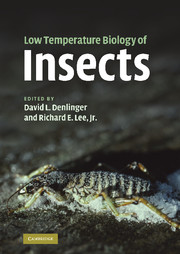Book contents
- Frontmatter
- Contents
- List of contributors
- Preface
- PART I PHYSIOLOGICAL AND MOLECULAR RESPONSES
- PART II ECOLOGICAL AND EVOLUTIONARY RESPONSES
- 8 The macrophysiology of insect cold-hardiness
- 9 Evolutionary physiology of insect thermal adaptation to cold environments
- 10 Insects at not so low temperature: Climate change in the temperate zone and its biotic consequences
- 11 Genetic variability and evolution of cold-tolerance
- 12 Life-history adaptations to polar and alpine environments
- PART III PRACTICAL APPLICATIONS
- Index
- References
9 - Evolutionary physiology of insect thermal adaptation to cold environments
from PART II - ECOLOGICAL AND EVOLUTIONARY RESPONSES
Published online by Cambridge University Press: 04 May 2010
- Frontmatter
- Contents
- List of contributors
- Preface
- PART I PHYSIOLOGICAL AND MOLECULAR RESPONSES
- PART II ECOLOGICAL AND EVOLUTIONARY RESPONSES
- 8 The macrophysiology of insect cold-hardiness
- 9 Evolutionary physiology of insect thermal adaptation to cold environments
- 10 Insects at not so low temperature: Climate change in the temperate zone and its biotic consequences
- 11 Genetic variability and evolution of cold-tolerance
- 12 Life-history adaptations to polar and alpine environments
- PART III PRACTICAL APPLICATIONS
- Index
- References
Summary
Introduction
Body temperature influences all aspects of the physiology and ecology of insects and indeed of all other ectotherms (Cossins and Bowler, 1987; Chown and Nicolson, 2004; Angilletta, 2009). Extreme low or high temperatures are physiologically damaging or even lethal, but temperatures well within those critical limits have profound effects on performance and fitness. Not surprisingly, an insect's thermal sensitivity plays a key role in its behavior, ecology and fitness.
Here I review several consequences of insect adaptation to low temperature. My focus is largely on organismal and population-level consequences. I take a macrophysiological approach (Chown et al., 2004) and focus on four key issues: some are classical, but others have only recently received attention: (a) Do optimal and critical temperatures correlate inversely with latitude, indicating that high-latitude species have adapted evolutionarily to low temperatures? (b) Are high-latitude species, which live in seasonal environments, physiologically adapted to a broader range of temperatures than are low-latitude species? (c) Do species with low optimal temperatures have the same maximal rates of population growth as do species with high optimal temperatures, as might occur if biochemical adaptation compensates fully for the thermodynamically depressing effects of low temperature? (d) Are cold-adapted, high-latitude species at greater risk from climate warming than are warm-adapted, low-latitude species, as might be expected given the faster rate of climate warming at high latitudes?
- Type
- Chapter
- Information
- Low Temperature Biology of Insects , pp. 223 - 241Publisher: Cambridge University PressPrint publication year: 2010
References
- 18
- Cited by



